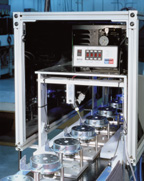
The company offers original equipment manufacturers (OEMs) dozens of standard switch configurations that can be factory-calibrated to an individual manufacturer’s specifications. This innovative approach allows Tridelta to offer its customers greater design flexibility at no additional cost and without long lead times often associated with custom products.
The calibration screw sits in a small well. After the screw has been adjusted to the OEM-specified set point, the well is filled with adhesive to keep the screw in position and discourage tampering. Since screw height and displacement vary with the switch configuration, the amount of adhesive needed to fill the well is different for each job.
Squeeze Bottles Major Factor in Bottleneck
Until recently, the adhesive-application/curing process was a time-consuming, labor-intensive batch operation accompanied by frequent bottlenecks.Tubs of calibrated switches were carried to dispensing tables, where they were unloaded and placed in racks. Operators then used plastic squeeze bottles to carefully fill the wells with a water-based adhesive. Since there was no way to control the amount of adhesive dispensed, they would often apply more than necessary and have to wipe off the excess. Although the water-based adhesive was relatively inexpensive, waste-related costs and cleanup time were significant.
Once all the switches in a rack had been filled with adhesive, the rack was placed under a fan to speed the curing process. At least five minutes was required for the adhesive to form enough of a “skin” so that the switches could be handled and boxed. Since final curing and quality-control audits had to take place before the order could be shipped, there was often a considerable backlog of product on the shop floor.
Taking Advantage of New Technology
To minimize work in process and reduce non-value-added activity, Senior Manufacturing Engineer Anthony Ciarlillo explored the benefits of changing from the water-based adhesive to an adhesive from ThreeBond International, Inc., West Chester, Ohio, that cures quickly under ultraviolet light. He also researched replacing the racks and dispensing tables with four new automated-dispensing/curing lines.Even though the new adhesive was 10-times as expensive as the old one ($300/gallon vs. $30/gallon), and an investment in capital equipment was required, a cost/benefit analysis showed the extra expense would be more than offset by higher efficiency and productivity.
To keep the cost of the new assembly lines down and expedite their implementation, off-the-shelf equipment was used wherever possible. Application-specific components, such as universal fixtures capable of accommodating all of Tridelta’s various switch designs, were fabricated in-house.
Air-operated 752V dispense valves from EFD Inc., East Providence, R.I., offered the accuracy, fast cycle rate and drip-free cutoff needed to rapidly fill each well with a consistent volume of adhesive. Each valve was paired with a microprocessor-based EFD VALVEMATE controller that makes it simple to adjust shot size for different switch designs and screw depths on-line, without stopping production.
Using a dedicated valve controller also eliminates the need to reprogram the main programmable logic controller (PLC) for product changeovers – a very useful feature when dealing with so many different product styles and specifications. Adhesive is cured with an Ultracure system from EFOS Inc., Mississauga, Ontario, Canada.

Fast Results and Multiple Benefits
The new dispensing/curing lines quickly eliminated the bottleneck by providing much faster throughput with minimal parts handling. Under the new system, a calibrated switch is handled only once – when it is placed in the fixture that moves it along the conveyor to the dispensing station.As the switch moves into position under the tip of the valve, the PLC signals the EFD valve controller to start the timed dispensing cycle, and in less than a second the well is filled with the correct amount of adhesive. Curing under the EFOS unit takes about another four seconds.
Tridelta’s investment in new adhesive and dispensing/curing technology is saving the company approximately $70,000 per year, through a combination of higher output, less work in process and greater overall efficiency:
- Overall productivity has increased between 25%-30%.
- The new adhesive/equipment combination has made the dispensing/curing process extremely accurate and virtually instantaneous. Product appearance is more consistent, and process time has dropped from more than five minutes to less than five seconds.
- Non-value-added activity, such as redundant product handling, has been eliminated, and work in process is kept to a minimum.
- The universal switch fixtures, dedicated valve controllers and adjustable curing equipment provide the flexibility to handle any product configuration with just a few minutes of setup time.
- To maintain output under the old system, as many as four operators were required at each dispensing station. With the new system, only one operator is needed to load the fixtures on each assembly line.
Conclusion
Stepping back to take a critical look at its dispensing process has helped Tridelta move from a time-consuming batch process to an efficient, continuous-flow system without bottlenecks or backlogs.In addition to increasing throughput, the new system design allows Tridelta to perform Statistical Process Control functions online, which has eliminated the need for lengthy quality audits. Switches are now packed as they come off the line, fully cured and ready for immediate shipment.
For more information on dispense valves, contact EFD Inc., 977 Waterman Ave., East Providence, RI 02914-1378; phone 800-556-3484; fax 401-431-0237; visit www.efd-inc.com. Or Circle No. 68.
For more information on low-pressure air switches, contact Tridelta Industries, Inc., 7333 Corporate Blvd., Mentor, OH 44060-4856; phone 440-255-1080; fax 440-255-2831; visit www.tridelta.com. Or Circle No. 69.
For more information on ThreeBond adhesives, contact ThreeBond International, Inc., 6184 Schumacher Park Drive, West Chester, OH 45069; phone 513-779-7300; fax 513-779-7375; visit www.threebond.com. Or Circle No. 70.
For more information on ultraviolet-curing systems, contact EFOS Inc., 2260 Argentia Rd., Mississauga, ON L5N 6H7 Canada; phone 905-821-2600; fax 905-821-2055; visit www.efos.com. Or Circle No. 71.